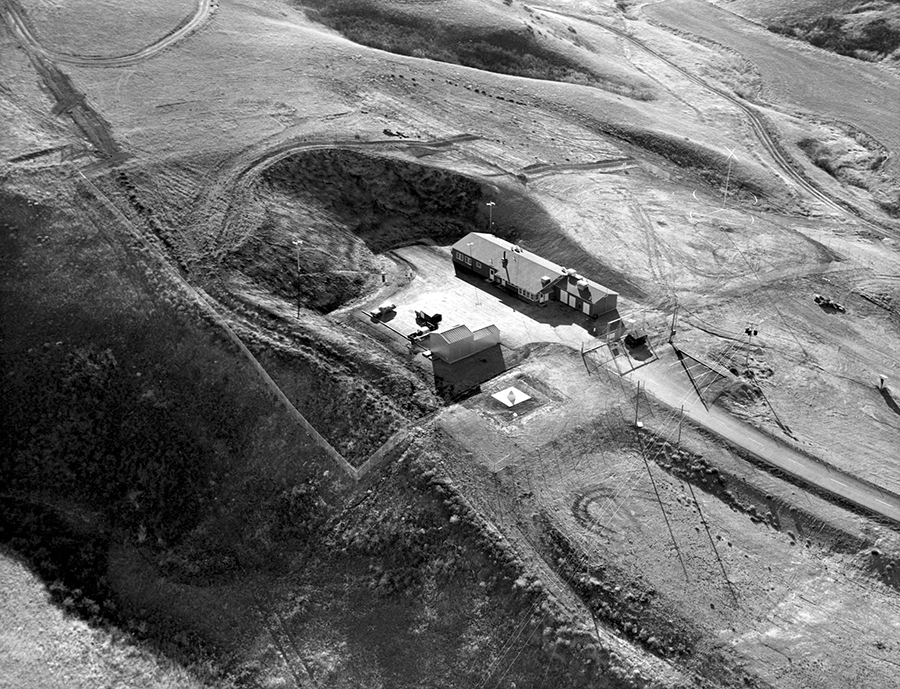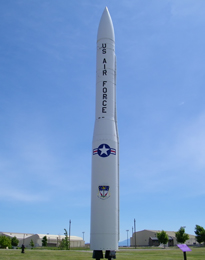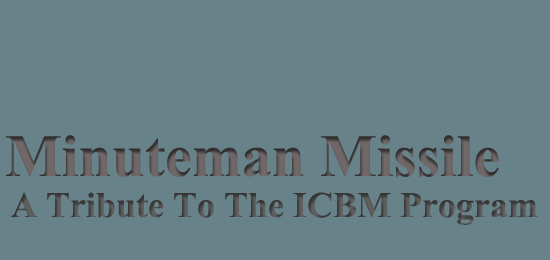
Alpha 01 Launch Control Facility Malmstrom AFB
Ground Based Strategic Deterrent
The Ground Based Strategic Deterrent program, GBSD, was created by the Air Force for the purpose of developing the next generation ICBM.
The current ICBM, the Minuteman III missile, presently on strategic alert at FE Warren, Minot and Malmstrom Air Force bases, was first deployed in 1970. Since that time the Minuteman III has seen a number of Life Extension programs implemented, to assure that the MMIII missile will be viable until 2030. Given that the Minuteman missile is coming to its end of use, prompted the creation of the Ground Based Strategic Deterrent program.
GBSD Information
Given that the GBSD program is still in its early stages of development, this website's author has only preliminary information regarding this program. The author feels that given the significance of this program, the information that has been released thus far will be made available here on this site. As new information becomes available, it will be added here accordingly.
The GBSD program was created by the Air Force to design, develop and deploy a new generation ICBM that includes launch and command and control structures. Much has changed in terms of the technology and defensive measures currently used in the ICBM weapon system currently on strategic alert. The Air Force understands the necessity to evolve in meeting current, as well as unknown future threats, regarding the ICBMs that make up the nuclear deterrent force, here in the United States.
Early estimates placed the budget of deploying the next generation ICBM at $29 billion dollars. Another source states the budget for the GBSD is approximately $39 billion dollars.
In 2016 the Air Force estimated this program would cost approximately $62.3 billion for the new missile, consisting of a total of 400 GBSD missiles for deployment, and additional missiles to allow for testing and launch research. In response to the 2016 estimate given by the Air Force, the Department of Defense has stated that their Cost Assessment and Program Evaluation office, CAPE, are stating an estimate of closer to $85 billion dollars for the new GBSD system.
On July 29, 2016, the Air Force solicited contract proposals from the industry to replace the Minuteman III missile and its weapon system. Lockheed Martin, Boeing, and Northrop Grumman were the 3 companies who submitted proposals. On August 21, 2017 the Air Force announced that it was giving the two Technology Maturation and Risk Reduction, TMRR, contracts to Boeing and Northrop Grumman. These two companies have until 2020 to submit their design for the new GBSD, at which time the Air Force will determine which proposal will fit their requirements. The new GBSD will be deployed by 2030.
Of interest to the reader, is an article published in the February 2018 Air Force Magazine, titled, "Replacing Minuteman." It discusses a number of factors pertinent to the new GBSD program, and what the Air Force is already considering and making known to both Boeing and Northrop Grumman, in their preparation for their proposals for GBSD. Click on the link below to read this article.
As stated in the article, the Air Force has determined that they will be able to continue to use the current Launch Facilities that house the 400 deployed Minuteman III missiles, located at FE Warren, Minot and Malmstrom Air Force Base. In realizing that the cost of the developing and constructing 400 to 450 new Launch Facilities would be extremely expensive. Through analysis of the current Launch Facilities, it was determined that these missile silos are still solid, and can be used with the new GBSD.
It is important to note, that with the programmed depot maintenance that began on all of the 450 Launch Facilities at the three missile wings, has allowed the Air Force to place 50 of these launch facilities into what some have termed these Launch Facilites as "warm silos". The depot maintenance started in 2017. Each missile wing has been removing the entire Minuteman missile from 17 of their Launch Facilities, and performing thorough maintenance and renovation of these Launch Facilities. Once completed, they return the missile back to the LF, and start maintenance on the next Launch Facility slated for the depot maintenance of that respective missile wing.
This is providing the Air Force a means to be in compliance with the New START treaty - having 400 Minuteman missiles, down from 450, but allowing the Air Force to maintain the 50 empty Launch Facilities in a "warm silo" status. It also allows the Air Force the much needed thorough maintenance on these Launch Facilities, some of which have been on strategic alert since 1962.
Once the GBSD program has designed and built the new generation ICBM, the Air Force will be able to utilize these up to spec Launch Facilities to house and place on strategic alert the new GBSD missiles.
Another essential feature for the new generation ICBM was discussed in the article mentioned above, which outlined the importance of building an "open system" with this new ICBM. Given the scenario that one part of the new GBSD missle needs to be updated, or outright replaced with an improved component, say the guidance system, it will be crucial that by designing and installing a new component into the new GBSD missile, this component will not have a proprietary feature to it. This will allow for a more efficient, as well as cost effective feature, that will eliminate the need to replace an entire system, and will allow for just that one new component to be installed seamlessly with the rest of the missile.
GBSD Update September 2022
LGM-35A Sentinel
In April 2022 Air Force Global Strike Command announced the name of the ICBM that will be replacing the Minuteman III missile. This missile will be called Sentinel.
Following the update on the new name for the missile replacing Minuteman III, the Ground Based Strike Deterrent program released a draft EIS statement in early July, 2022. Follow the link below to the GBSD site to view the multiple PDFs outlining the EIS documents.
There are a number of unknowns regarding the Sentinel missile, and the overall GBSD program and infrastructure, however the draft EIS provides one with a number of features that appear to be what the Sentinel missile and the entire weapon system and infrastructure will bring forth in replacing the Minuteman missile.
LGM-35A Sentinel Features
Four features that the Sentinel LGM-35A will provide are:
- Increased acccuracy
- Extended range
- Enhanced security
- Improved reliability
The Air Force have plans to launch their first test flight of a Sentinel missile from Vandenberg Air Force Base in 2023.
The Air Force has contracted with Lockheed Martin to redesign the Mk21A to carry 300 kiloton W87-1 nuclear warheads for the Sentinel missile.
There are statements indicating the Sentinel missile is going to be heavier than the Minuteman missile, which will require all transport vehicles to be updated.
GBSD will be replacing the Missile Guidance System formerly used with the Minuteman missile, and the Sentinel missile will incorporate a new MGS, Missile Guidance System.
Missile Alert Facility (MAF) Launch Centers (LC) And Launch Facilities
Again, given the preliminary information available, there are certain aspects of the GBSD that are not known. That said, the GBSD system will implement the design where each missile wing consisting of 15 Missile Alert Facilities will completely refurbish 8 out of the 15 current MAFs to like new status, and decommission the remaining 7 MAFs. Based on this layout, each MAF will be responsible for more than the former flight of 10 missiles per MAF.
Due to the New Start treaty (which has been extended out to 2026) this allows for a total of 400 missiles at FE Warren AFB, Malmstrom AFB and Minot AFB combined. Each missile wing currently have 150 Launch Facilities with approximately 15 to 16 of those Launch Facilities per missile wing being placed into what they call a "warm silo" status.
A "warm silo" consists of a Launch Facility that is empty, sans a missile, but that silo is still active - the equipment is all intact and if need be, a missile from an active Launch Facility can be pulled and placed into that empty "warm silo" and placed on strategic alert with no down time.
The GBSD draft EIS states that a Communication Support Building will be constructed, seemingly at each of the remaining 8 MAFs. Whether these facilities will retain the Missile Alert Facility title, is unknown at this time.
Communication Towers
The new GBSD program will also be contructing 62 communication towers at the three missile wings. These towers will be up to 300 feet tall. The plan is to build 18 towers at FE Warren AFB, 31 at Malmstrom AFB, and 13 at Minot AFB.
It appears that the GBSD system will no longer utilize the underground Hardened Intersite Cable System that provided the Missile Alert Facilities command and control of the Launch Facilities. Based on this preliminary information regarding the communication towers, the Air Force will be primarily monitoring and have the capacity to send a launch command for the Sentinel missiles utilizing air (radio) frequencies.
Workplace Hubs
Given the extensive amount of work required of the women and men who will be building all of these structures and necessary features to make the GBSD program operational, the plan is to construct a total of 4 Workplace Hubs, to house from 2000 up to 3000 workers at each of these four hubs.
The plan is to construct one hub in Nebraska, one in Great Falls, Montana, a third workplace hub in Lewistown, Montana, and the fourth will be in Minot, North Dakota.
GBSD - Full Deployment
The Air Force has determined that the GBSD system (400 missiles, 24 Missile Alert Facilities) will be fully deployed and operational by 2036.
Based on the research, design and development of the Ground Based Strike Deterrent, the Air Force intends to make the GBSD viable until 2075.

